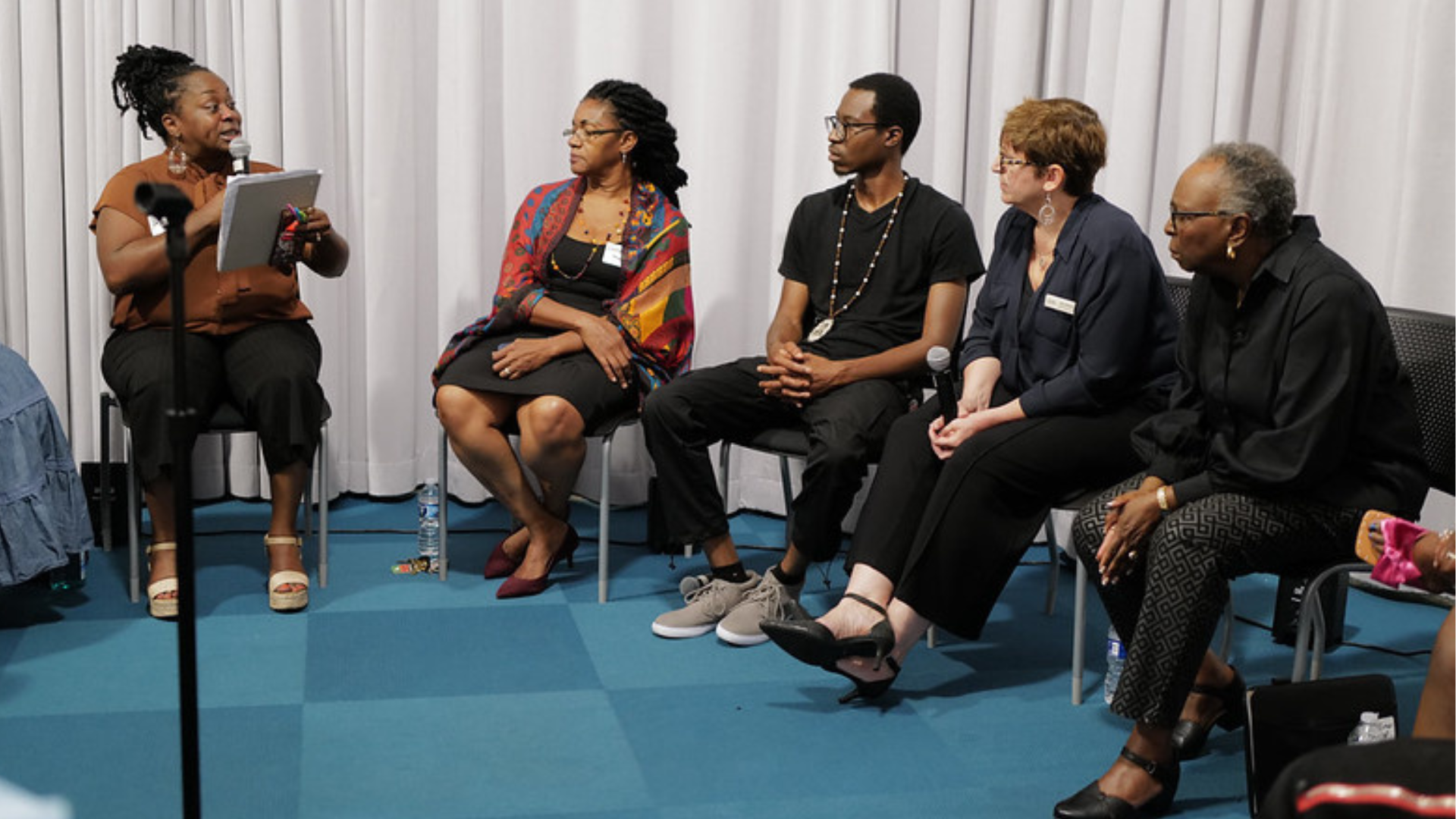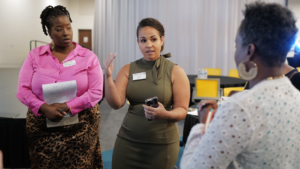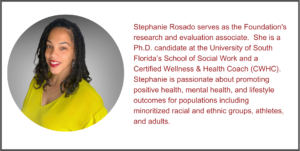Don’t have time to read the full BIPOC Mental Health Scan? We’ve got you!

Below we answer five key questions to break down some of the report’s most important information.
1. Why was the BIPOC mental health scan done and what was its purpose?
The purpose of the scan, which was conducted on the Foundation’s behalf by Dr. Keesha Benson and Dr. Stephanie Reed, is to better understand the mental and behavioral health landscape for Black, Indigenous, and People of Color (BIPOC) in Pinellas County, with a focus on South St. Petersburg. This is important because research has shown that BIPOC communities suffer the greatest health disparities. (Health disparities are differences in health or health care between groups that stem from broader inequities or injustices.) Cultural nuances, attitudes, perceptions about mental health, and lack of access to culturally competent care in BIPOC communities create even more barriers and vulnerabilities for poor mental health outcomes.
2. So, what questions did this research scan aim to answer?
This research scan aimed to answer the following questions:
- What can we learn about BIPOC mental health from regional and national data?
- How do BIPOC community stakeholders perceive the current program/service delivery landscape in Pinellas County?
- What is the current landscape for BIPOC mental health programs and services in Pinellas County?
- What professional development opportunities exist for mental health workers to become culturally competent in providing mental health services to BIPOC communities? (See findings in Appendix A p. 64 of the report.)
- What networks exist locally and nationally for professionals to support BIPOC mental health? (See findings in Appendix A p. 64 of the report.)
3. What did we learn about BIPOC mental health from the regional and national data and why is this information important?
By looking at regional and national data, we were able to learn about eight broad areas of BIPOC mental health. These areas include: 1) population statistics; 2) diagnosis; 3) suicide; 4) unmet needs; 5) treatment; 6) barriers; 7) homelessness and behavioral health; and 8) gender identity and sexual orientation. A brief summary of findings is provided below; check out the full report for details on each area.
- In 2021, 22.8% of the adult population in the United States had a mental illness, with 5.5% of those having a serious mental illness.2 Persons of two or more races have the greatest prevalence of having a mental illness at 34.9%.
- In Florida, 2020 data indicates that Black and Hispanic populations are less likely to have been told that they have a depressive disorder,3 but it is important to recognize that help-seeking behavior and barriers to accessing care may explain this. Some commonly cited barriers to care include the stigma associated with mental illness, lack of culturally competent services, cost, lack of diversity among providers, and the perception that treatment will not help.
- In Pinellas County specifically, data from 2019 shows an increase in the number of adults reporting poor mental health and children aged 11-17 attempting self-harm or experiencing feelings of sadness and hopelessness. In addition, a Community Health Needs Assessment showed that 45% of Pinellas residents ranked behavioral health as a leading health concern, with more than one-third of Indigenous adults indicating unmet mental health needs. Sixteen percent (16%) of Black adults and 25% of adults who identify another way indicated unmet mental health needs.
- The intersection of different marginalized identities or experiences—such as homelessness, LGBTQIA+, and race—can significantly influence an individual’s mental health needs and overall healthcare encounters.
- According to population projections, by 2050, the majority of people in Pinellas County will be people of color, whereas, in 2016, BIPOC only made up 25% of the population1.
- This information highlights the urgent need for the behavioral healthcare landscape and workforce to enhance access, expertise, and services for the growing BIPOC community in Pinellas County.
4. How do BIPOC residents and providers who service BIPOC communities perceive the mental health service delivery landscape in Pinellas County?
Through focus group interviews with BIPOC residents and survey responses from working with BIPOC communities, we gained insight into the present state of mental health service delivery in Pinellas County.
Here are some of the themes that emerged from BIPOC residents:
- Residents’ mental health needs, attitudes toward mental health, and priorities were often informed by childhood experiences.
- Experiences of racial inequities and racism have a significant impact on mental and behavioral health. These experiences have long-lasting consequences, both personally and across generations.
- Representation matters: It’s important to people to find “the right” provider who looks like them and understands their experiences and cultural nuances.
- It’s important for people to take care of themselves first so that they can care for others.
- Many BIPOC community members value a sense of community.
- Barriers to mental health included extensive time and effort required to obtain services, stigma, and a lack of affordability, health insurance coverage, culturally competent services, time, outreach to and within BIPOC communities, service availability (distance, workforce/staffing issues, etc.), and variety in types of mental health services available.
- Many BIPOC residents interviewed were either not familiar with the term “racial equity” or felt it wasn’t present in services they’ve received – and wished it were.
- More needs to be done to address the mental health needs of BIPOC individuals in Pinellas County.

“I feel like for a lot of people, it’s difficult enough to find a therapist or a psychiatrist, which means it’s even more difficult to find one of color.”
-Pinellas County Resident
Providers who service BIPOC residents were aware of many of the barriers to mental health care people face and offered insight on community needs as well as strategies to help serve BIPOC communities.
Here are some of the themes that emerged from providers:
- Capacity issues create barriers to service delivery (i.e., long wait lists, large caseloads, lack of workforce training, etc.).
- Providers recognize the importance of culturally informed practices and DEI training.
- Providers engaged in professional development opportunities to help them serve the unique mental health needs of BIPOC communities. Trainings covered topics like race, racism, trauma, diversity, equity, inclusion, and more.
- Providers identified a variety of treatment interventions and therapeutic approaches, but overall, providers fell into two categories: 1) they either use a specific framework/approach when working with BIPOC individuals or 2) their approach varies and depends on the client.
- Half of the providers stated that they use the same assessment tools for all clients—no tailored assessment tools for BIPOC clients.
- Strategies informing client-centered care that honors the intersectionality of all identities among BIPOC clients vary among providers: listening to and learning from clients, medical models, and research/trainings.
“Recruitment of mental/behavioral health professionals that ‘look like’ or represent the community of people to be served is often a barrier, made more difficult by the substandard salaries and benefits nonprofits are expected to pay.”
-Pinellas County Provider
Both providers and community members agree that more needs to be done to prioritize and address the needs of BIPOC mental health in Pinellas County.
5. Now what? What recommendations resulted from the findings of the BIPOC Mental Health Scan?
To address the mental health needs of BIPOC communities in Pinellas County and South St. Petersburg, the scan recommends:
- Culturally responsive education to BIPOC communities to decrease stigma around mental illness
- Curation of shared spaces among BIPOC for intergenerational community conversations to normalize talking about mental health
- Acknowledgement of the impact of intergenerational trauma and racism on mental health for BIPOC communities
To address the structural barriers for BIPOC mental health in Pinellas County and South St. Petersburg, recommendations are to:
- Conduct outreach about mental health services in community spaces where BIPOC communities connect
- Advocate for increased reimbursement rates for mental health services
- Advocate for increased public funding for mental health services
- Engage BIPOC communities in mental health prevention and early intervention to decrease crisis care and suicides.
- Streamline the mental health system of care to make it easier to navigate
For mental health professions, organizations, and professionals, recommendations are to:
- Recruit and retain more BIPOC mental health providers
- Provide culturally responsive training for non-BIPOC providers to help them better engage with BIPOC communities
- Create a safe, easy way for patients to identify mental health service providers who align on multiple identities and who competently serve BIPOC communities
- Help mental health providers and organizations assess the cultural appropriateness and quality of care they provide to the BIPOC community
We hope that this breakdown of some of the most pertinent information from the report helped you digest the material, think critically about how we can advance racial equity for BIPOC mental health, and encourages you to dive deeper into the full report. To watch a video recording of the Foundation’s data walk on the scan’s findings, click here.

References
- (2019). An Equity Profile of Pinellas County. Retrieved from California: Pollitt, A. M., & Mallory, A. B. (2021). Mental and Sexual Health Disparities Among Bisexual and Unsure Latino/a and Black Sexual Minority Youth. LGBT Health, 8(4), 254-262.doi:10.1089/lgbt.2020.0374
- (2015-2019). National Survey on Drug Use and Health, . Retrieved from
- Florida Department of Health. (2020). 2017-2019 Florida Risk factor Behavioral risk Factor Surveillance System. Retrieved from Tallahassee, FL: https://www.floridahealth.gov/statistics-and-data/survey-data/behavioral-riskfactor- surveillance-system/2019county/PinellasCombinedReport.pdf
